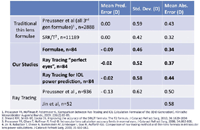Article
Theory may be edging out traditional formulas with regard to IOL power prediction
Accuracy of IOL power prediction using ray tracing is improving and approaching the performance of traditional regression formulae

Based on the progress being made, there is reason for optimism that ray tracing will eventually offer a technique that is superior to traditional formulae in achieving the desired postoperative refraction, said Arthur B. Cummings, MD, at the annual meeting of the American Society of Cataract and Refractive Surgery.
Dr. Cummings presented results from a study in which the accuracy of IOL power prediction using ray tracing was determined through back calculations in a series of 84 eyes.

For the purpose of the study, the biometry data were modified using proprietary software for optical modeling and ray tracing techniques (Project ClearSight) to obtain true optical properties and to compute the predicted refractive error of each eye.
Outcomes of the ray tracing and traditional formula methods were compared with the actual postoperative subjective refraction data.
The analyses showed that the mean ± SD prediction error was –0.02 ± 0.58 D using the ray tracing technique and –0.09 ± –0.46 D using the SRK/T formula.
The mean absolute prediction error was 0.44 ± 0.39 for ray tracing and 0.34 ± 0.33 D using SRK/T.
Predictability analyses showed that the proportion of eyes within 0.25 D of refraction was 37% using ray tracing and 47% for the traditional formula while 68% of eyes using ray tracing and 77% of eyes using the SRK/T were within ±0.5 D of target refraction.
"The results in this study of 'normal' eyes show the prediction accuracy of ray tracing is closer to that of traditional formulae than ever before," said Dr. Cummings, who is in private practice, Wellington Eye Clinic, Dublin, Ireland. "The improving performance of this method is being achieved through software refinements, and it is a very satisfying and encouraging development for researchers in the field.
"Once instrumentation becomes available to obtain direct physical measurements of the optical properties of the individual eye, ray tracing holds promise to deliver refractive outcomes that are more accurate than regression formulae that are based on historical data from thousands of eyes, and regardless of axial length or any history of previous refractive surgery," he added.
Citing results from two published studies, Dr. Cummings demonstrated that the outcomes achieved in the current study were superior to those reported previously by investigators using ray tracing, both with respect to mean absolute prediction error and standard deviation.
"In a study including almost 1,000 eyes, Preussner and Olsen [J Cataract Refract Surg. 210;36:1829-1834] found a mean ± SD prediction error of –0.13 ± 0.62 D, while Jin et al. [J Cataract Refract Surg. 2009;36:65-62] reported a mean absolute error of 0.58 D using ray tracing for IOL power calculation in 52 eyes," Dr. Cummings said.
